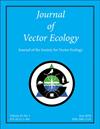入侵木本植物是蜱传病原体的焦点:大平原南部的东部红雪松
IF 1.3
3区 农林科学
Q2 ENTOMOLOGY
引用次数: 6
摘要
摘要:病媒对栖息地的偏好和利用与经常经历人为环境变化的景观直接相关。美国发生的一种主要的土地利用变化是草原上本地和非本地木本植物物种的扩张,但人们对这种扩张对区域病媒传播疾病传播的影响知之甚少。在这项研究中,我们重点研究了东部红雪松(Juniperus virginiana;ERC)扩张的影响,并测试了两个假设,涉及俄克拉荷马州中部农村栖息地成年蜱虫物种栖息地偏好之间的关系。使用CO2捕集器,我们从两种密度的ERC和草地收集蜱虫,并筛选成年蜱虫是否存在病原体DNA。我们发现,在ERC栖息地采集的美洲Amblyomma americanum(Linnaeus)和变异Dermacentor variabilis(Say)明显多于草原。我们的第二个假设也得到了支持,因为埃立克体和立克次体感染的美洲A.americanum比草原更有可能从ERC栖息地采集。作为将木本植物入侵与美国大陆重要的蜱传病原体联系起来的第一个证据,这些结果对人类和伴侣动物在大平原南部遇到病原体感染的蜱虫的风险产生了重要影响。本文章由计算机程序翻译,如有差异,请以英文原文为准。
Invasive woody plants as foci of tick-borne pathogens: eastern redcedar in the southern Great Plains
ABSTRACT: Habitat preference and usage by disease vectors are directly correlated with landscapes often undergoing anthropogenic environmental change. A predominant type of land use change occurring in the United States is the expansion of native and non-native woody plant species in grasslands, but little is known regarding the impact of this expansion on regional vector-borne disease transmission. In this study, we focused on the impact of expanding eastern redcedar (Juniperus virginiana; ERC) and tested two hypotheses involving relationships between habitat preferences of adult tick species in rural habitats in central Oklahoma. Using CO2 traps, we collected ticks from two densities of ERC and grassland and screened adult ticks for the presence of pathogen DNA. We found support for our first hypothesis with significantly more Amblyomma americanum (Linnaeus) and Dermacentor variabilis (Say) collected in ERC habitats than in grassland. Our second hypothesis was also supported, as Ehrlichia- and Rickettsia-infected A. americanum were significantly more likely to be collected from ERC habitats than grassland. As the first evidence that links woody plant encroachment with important tick-borne pathogens in the continental United States, these results have important ramifications involving human and companion animal risk for encountering pathogen-infected ticks in the southern Great Plains.
求助全文
通过发布文献求助,成功后即可免费获取论文全文。
去求助
来源期刊

Journal of Vector Ecology
生物-昆虫学
CiteScore
2.60
自引率
5.90%
发文量
31
审稿时长
6-12 weeks
期刊介绍:
The Journal of Vector Ecology is an international journal published by the Society for Vector Ecology. It is concerned with all aspects of the biology, ecology, and control of arthropod and vertebrate vectors and the interrelationships between the vectors and the agents of disease that they transmit. The journal publishes original research articles and scientific notes, as well as comprehensive reviews of vector biology based on presentations at Society meetings. All papers are reviewed by at least two qualified scientists who recommend their suitability for publication. Acceptance of manuscripts is based on their scientific merit and is the final decision of the editor, but these decisions may be appealed to the editorial board. The journal began publishing in 1974 and now publishes on-line only.
 求助内容:
求助内容: 应助结果提醒方式:
应助结果提醒方式:


